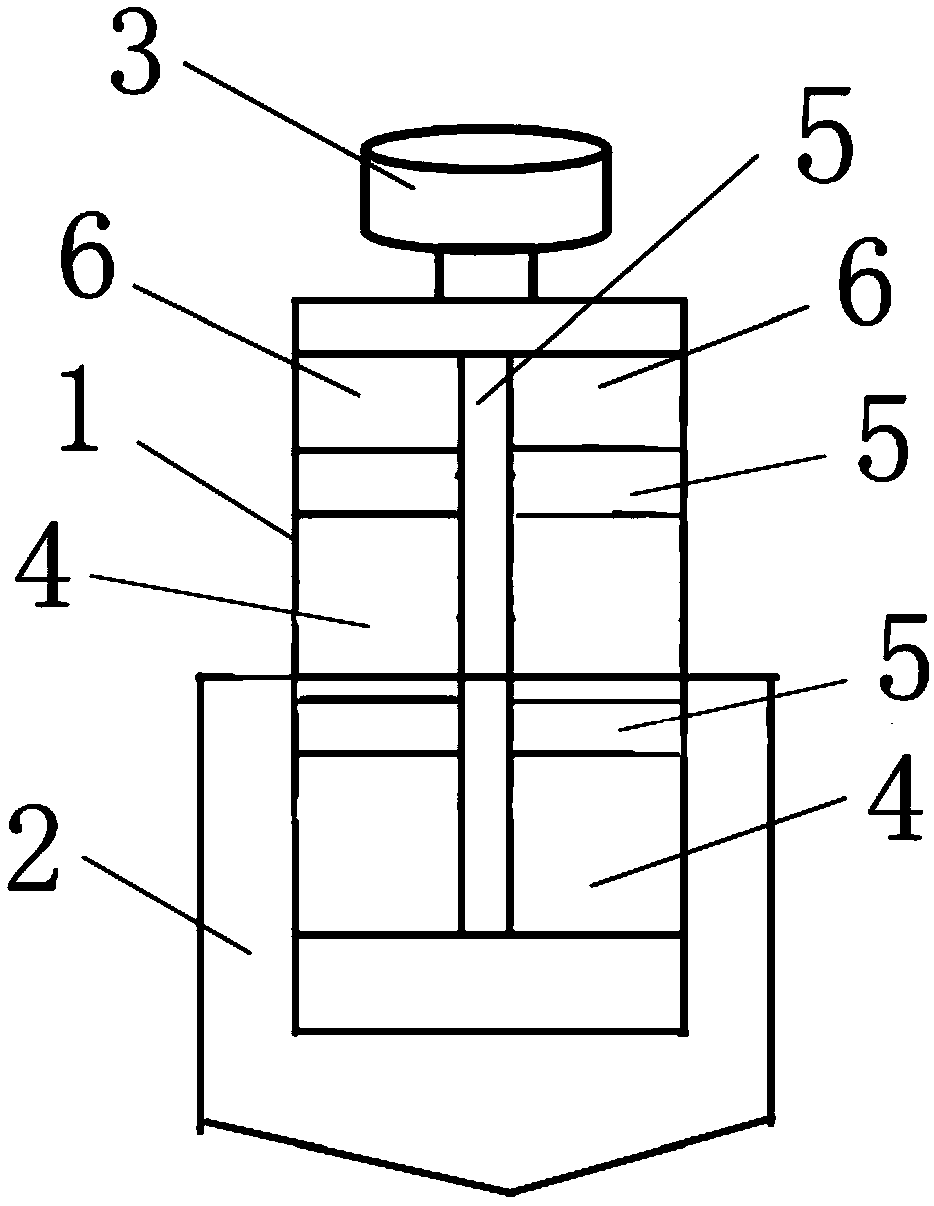Chemical ingredient detecting device
A technology for chemical composition and detection device, applied in the field of chemical detection, can solve the problems of single detection composition, small scope of application, complicated operation, etc., and achieve the effect of simple, easy-to-operate and high integration of devices and auxiliary equipment
- Summary
- Abstract
- Description
- Claims
- Application Information
AI Technical Summary
Problems solved by technology
Method used
Image
Examples
Embodiment 1
[0035] The chemical composition detection device in this example is as figure 1 As shown, it is composed of an inner core 1, an outer jacket 2 and a handle 3. The outer jacket 2 has openings at both ends and covers the lower part of the inner core 1. The upper end of the inner core 1 is connected to the handle 3; the upper part of the inner core 1 is provided with a terminal area 6, Three detection areas 4 are arranged below the terminal area 6, an isolation area 5 is arranged between the detection area 4 and the terminal area 6, and isolation areas 5 are also arranged between the detection areas 4; the terminal area 6 contains anhydrous copper sulfate, three Each detection zone 4 contains litmus acid-base indicator, aromatic sulfamic acid and turmeric respectively, and the isolation zone 5 is blank.
[0036] The inner core 1 is made of water-absorbent material. Overcoat 2 is made of materials such as metal, glass, quartz or organic polymer.
[0037] The inner core 1 is cyli...
Embodiment 2
[0050] The chemical composition detection device in this example is as figure 2 As shown, there are four detection areas 4, and the four detection areas 4 respectively contain litmus acid-base indicator, Hegler's reagent, 1-amino-2-naphthol-4-sulfonic acid, sulfite and hydroquinone Mixture, aspamine, {4-[(2,6-dibromo-4-nitrophenyl)nitrogen]-2-octacio-1-naphthol and 2,4,6,8-tetranitro- Mixture of 5-octadecylepoxy-1-naphthol, end zone 6 containing anhydrous cobaltous chloride. The inner core 1 is sheet-like.
[0051] This example is not equipped with auxiliary equipment.
[0052] In the preparation method of the inner core 1 of this example, litmus acid-base indicator solution, Heegler's reagent, 1-amino-2-naphthol-4-sulfonic acid, sulfite and hydrogen were added to the four detection areas 4 respectively. A mixed solution of quinones, aspamine, {4-[(2,6-dibromo-4-nitrophenyl)nitrogen]-2-octacio-1-naphthol and 2,4,6,8-tetra Mixed solution of nitro-5-octadecylepoxy-1-naphtho...
Embodiment 3
[0062] There are three detection areas 4 of the chemical composition detection device in this example, and the three detection areas 4 respectively contain complexes of 2,4-dinitrophenylhydrazone-4,5-diazafluorenone and ruthenium, lead acetate, and potassium iodide of starch , The end zone 6 contains hydrochromic silica gel.
[0063] This example is not equipped with auxiliary equipment.
[0064] In the preparation method of the inner core 1 in this example, the complex solution of 2,4-dinitrophenylhydrazone-4,5-diazafluorenone and ruthenium, lead acetate solution, and starch potassium iodide solution are respectively added to the three detection areas 4 . The end area 6 is coated with water-discolored silica gel, and then placed in an oven at 50° C. until the end area 6 is dehydrated and discolored to obtain the inner core 1 .
[0065] The preparation method of the color comparison card in this example is as follows:
PUM
 Login to View More
Login to View More Abstract
Description
Claims
Application Information
 Login to View More
Login to View More - R&D
- Intellectual Property
- Life Sciences
- Materials
- Tech Scout
- Unparalleled Data Quality
- Higher Quality Content
- 60% Fewer Hallucinations
Browse by: Latest US Patents, China's latest patents, Technical Efficacy Thesaurus, Application Domain, Technology Topic, Popular Technical Reports.
© 2025 PatSnap. All rights reserved.Legal|Privacy policy|Modern Slavery Act Transparency Statement|Sitemap|About US| Contact US: help@patsnap.com


